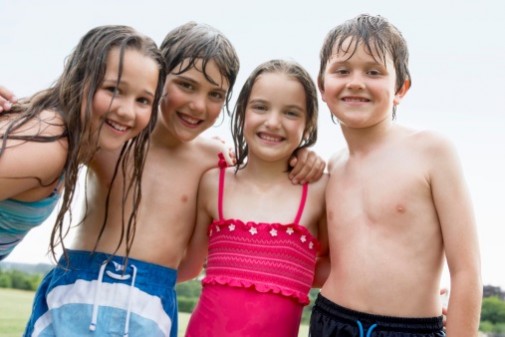
Sun safety
Just one sunburn during childhood increases an individual’s risk of melanoma which is the deadliest form of skin cancer. This is why sunscreen is absolutely essential for children and adults when outside.
Select a sunscreen with a sun protection factor (SPF) of at least 30 and reapply every two hours and immediately after swimming (even if the bottle says “waterproof” or excessive sweating for optimum protection.
When applying sunscreen, don’t forget to cover your child’s entire body; do not forget their ears, tops of the feet and along the scalp.
Stay hydrated
Children dehydrate faster than adults. Be sure to have your child drink plenty of fluids to prevent dehydration. Don’t wait for your child to tell you she is thirsty. Preschoolers need about 45 ounces of fluid a day which is equal to about five glasses. Grade-school kids need about 64 ounces a day, or eight glasses. Stick to water and avoid sugary sodas or juices.
Avoid hot cars
Temperatures in a closed car rise rapidly in the sun and can approach 160 degrees in a matter of minutes. Never leave your child unattended in the car, even if it is just for a few minutes to run a quick errand. Every year dozens of children die from heat stroke from being left in cars. Make sure your car doors and trunk are locked when parked in the driveway or garage so that your child is not tempted to play in the car.
Bike Safety
Parents should always be good role models, which means always wearing a helmet when riding your bike. Have your child wear a helmet when riding on the back of your bike or while being pulled in a bike trailer.
For older children, insist that they wear a helmet when on the bicycle, tricycle or scooter. Like seat belts in the car, wearing a helmet when biking is necessary! As an emergency department physician, I care for many kids who suffer head injuries while biking. Many would have been fine if they had only been wearing a helmet. Check that your child’s helmet fits properly, it should be centered on the top of the head with the strap buckled and snug enough that it doesn’t rock back and forth or from side to side. A helmet damaged during a previous fall should be replaced.
Finally, make sure all bikes are in good condition. This includes making sure that the tires are inflated properly and also make sure to check the brakes. Kids grow quickly so be sure that the seat and handle bars are adjusted properly for your child’s size.
Pool safety
Never leave a child unattended in or near water, even for a second. This includes swimming in a small “kiddie” pool with just a few inches of water. A child can become submerged in seconds, lose consciousness and sustain permanent brain damage in only four minutes -the time it takes to run inside the house to answer the phone or grab a towel! According to the American College of Emergency Physicians (ACEP), drowning is the second leading cause of children under fourteen. For every child who dies, more than ten others are treated in emergency departments for near drowning. When at a public pool or lifeguarded beach, always stay with your child even if she is wearing water wings or has taken swim classes. Stay close and supervise your child at all times to ensure the child’s safety in the water.
Boating safety
When boating with children remember they can fall into the water quickly. All boaters should wear properly fitting coast guard approved life vests at all times. Be sure each child has the proper sized safety vest and they are wearing it correctly. Care must be taken when water skiing and tubing. At Advocate Condell Medical Center, we recently saw a child killed while tubing – struck by an intoxicated boater. Parents and ski spotters must be vigilant! It is very easy for skiers to go under or get caught up in a tow rope at any moment. Kids should never jump into the water near a running motor. Finally, all boaters like drivers should always be sober and not distracted!
With a little planning and a watchful eye, we can all have a great summer. Have fun and be safe!









